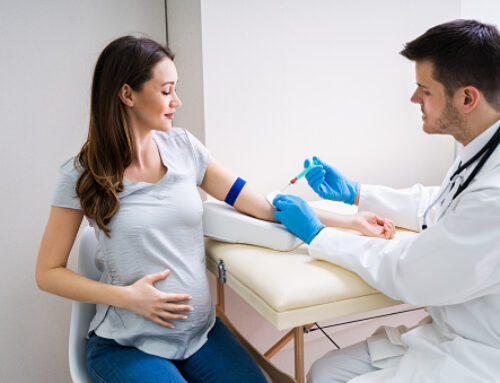Human papillomavirus (HPV) is the most common sexually transmitted infection in the United States and across the globe. The Centers for Disease Control and Prevention (CDC) confirms that nearly everyone will get an HPV infection at some point in their lives.
For some, HPV is harmless and clears up on its own, but for many others, especially women, it can be life-threatening. According to the CDC, more than 42 million Americans are infected with the high-risk types of HPV known to cause disease if left untreated.
Cervical cancer is one of the greatest risks for women, with almost all cases of cervical cancer directly linked to HPV. Thousands of women are diagnosed with this highly preventable cancer each year, largely due to missed screenings or a lack of awareness. TopLine MD Alliance and the top-tier OB/GYNs, gynecologists, and other women’s health specialists in our network would like to change that.
Keep reading to learn more about the connection between HPV and cervical cancer, the importance of regular Pap smears and HPV testing, and who should get the HPV vaccine for extra protection.
What is HPV, and how is it transmitted?
Human papillomavirus is a highly contagious virus that can affect many parts of your body. There are over 200 types of HPV, including strains of HPV that cause skin growths (such as warts) and others that cause cancer. About 30 strains of HPV can affect your genitals, including your vulva, vagina, and cervix (the lower part of the uterus that connects to the vagina).
HPV is usually transmitted through sexual contact, including vaginal, anal, or oral sex. It’s also possible to transmit the virus through hand-to-genital contact or other forms of skin-to-skin contact. But you don’t have to exchange bodily fluids to get HPV or spread it to someone else. Sharing food, drinks, or personal items (such as utensils, towels, or razors) with an infected person or touching contaminated surfaces can also put you at risk.
What types of HPV are linked to cervical cancer?
With so many types of HPV, scientists use a numeric system to categorize and identify different strains of the virus. HPV types are then grouped as low-risk or high-risk based on their association with genital warts, cervical cancer, and other negative health outcomes.
The HPV types most strongly linked with cervical cancer are 16 and 18, which are responsible for approximately 70% of cervical cancers. Other high-risk HPV types (including 31, 33, 35, 39, 45, 51, 52, 56, 58, and 59) also increase your risk of cervical cancer.
How does HPV cause cervical cancer?
Once high-risk HPV infects your cervical cells, the virus begins to interfere with how the cells grow, replicate, and communicate with one another. Over time, the infected cells begin to multiply in an uncontrolled manner, leading to the development of abnormal cells – a process called cervical dysplasia. HPV can also interfere with your body’s immune system and lead to repeated infections, further increasing your risk of cervical cancer.
Abnormal cell changes are not cancerous at first, but they can potentially progress to cancer if left untreated. The best way to check for any cell changes is with a Pap smear, a screening test where cells are collected from your cervix and then evaluated under a microscope (see below for more details). If abnormal cells are found, they must be watched closely or removed.
It can take years or decades for abnormal cells to grow, giving most women ample opportunity to detect precancerous cells before they turn to cervical cancer, as long as they get screened regularly.
What are the symptoms of HPV and cervical cancer?
Here’s another reason to visit your TopLine MD Alliance Network provider: you could have HPV and not even know it.
HPV
HPV that affects your genitals, including your cervix, does not usually cause any symptoms. When HPV symptoms do occur, the most common sign is warts on or inside your genital area(s). Genital warts often vary in appearance, from flat spots to cauliflower-like bumps. They rarely cause discomfort or pain, although they may itch or feel tender.
Genital warts can appear weeks, months, or even years after being infected with low-risk HPV, and like HPV, they are highly contagious. In women, genital warts appear most frequently on the vulva (the external female genital area, which includes the entrance to the vagina, the labia, and the clitoris).
High-risk types of HPV are equally contagious, but they are also usually symptom-free until they have already progressed to cancer, so don’t wait to get tested.
Cervical cancer
As it grows, cervical cancer may cause a variety of symptoms, including:
- Vaginal discharge that is watery, bloody, or has a foul odor
- Vaginal discharge that is heavier than usual
- Vaginal bleeding after intercourse, between periods, or after menopause
- Menstrual bleeding that is heavier and/or lasts longer than usual
- Pain during intercourse
- Pelvic pain
The symptoms of advanced cervical cancer include:
- Back pain
- Difficulty urinating or having bowel movements
- Blood in your urine or bowel movements
- Loss of appetite
- Weight loss
If you experience any of these symptoms, seek professional care ASAP. Early detection significantly improves your chances of successful treatment for both HPV and cervical cancer.
Who should get screened for cervical cancer, and how often?
According to the American Cancer Society, cervical cancer screenings are recommended for anyone with a cervix between the ages of 25-65, regardless of their sexual history or HPV vaccination status.
When and how often you should be screened will depend on your age, medical history, and other factors. However, the general guidelines are as follows:
- Ages 21-29 – Pap smear every three years
- Ages 30-65 – HPV test every five years, HPV test/Pap smear every five years, or Pap smear every three years
- Ages 65 and up – You may no longer need screening if you have no history of cervical changes and a consecutive history of normal test results (3+ negative Pap smears)
Have you had a hysterectomy? Screening may no longer be necessary if your cervix was removed during the procedure. But if your cervix is still present, you should get an HPV test/Pap smear every five years.
Talk to your TopLine MD Alliance Network provider about cervical cancer screenings so we can create the best schedule for you.
What’s the difference between a Pap smear and an HPV test?
Both tests help screen for cervical cancer, but they do so in different ways. Both tests can also spot issues before symptoms appear, when treatment works best. Cervical cancer used to be one of the leading causes of death for women in the United States, but the death rate has dropped significantly due to cervical cancer screenings.
A Pap smear looks for abnormal cells on your cervix that could cause cancer, while an HPV test detects the presence of the virus itself. Your TopLine MD Alliance Network provider may recommend co-testing, which means having a Pap smear and an HPV test at the same time.
Both tests are performed during a pelvic exam. During the exam, a speculum is gently placed into your vagina, then a soft brush or spatula is used to collect a small sample of cervical cells. The sample is sent to a pathology lab to be viewed under a microscope.
A positive Pap smear indicates the presence of abnormal cells, but it does not necessarily mean you have cancer. Usually, the first step is to repeat the test. If the result is still positive, your TopLine MD Alliance Network provider will proceed with the diagnosis and treatment of any precancerous cells.
A positive HPV test means a high-risk type of HPV was detected. Again, it does not mean you have cancer. HPV clears up on its own for most women, especially younger women, without treatment. However, your TopLine MD Alliance Network provider will closely monitor the infection and watch for any abnormal cell changes.
Can cervical cancer be prevented?
Yes, cervical cancer is highly preventable, thanks to the availability of cervical cancer screenings. Both Pap smears and HPV tests help detect precancerous cells in the cervix that can be treated before they develop into cancer.
Other ways to prevent cervical cancer include:
- Following up on any abnormal screening results promptly
- Getting regular pelvic exams
- Practicing safe sex (since HPV is spread through sexual contact)
- Eating a balanced diet and exercising regularly
- Not smoking
HPV vaccines also protect against the high-risk HPV strains responsible for most cases of cervical cancer, making vaccination another critical factor.
How effective is the HPV vaccine, and who should get it?
Studies show HPV vaccines are nearly 100% effective in preventing infections caused by the HPV types targeted by the vaccine, especially when the vaccine is administered before exposure to the HPV virus – ideally during adolescence. The HPV vaccine is recommended for all adolescents and young adults between the ages of 9 and 26, regardless of sex.
Other groups who may benefit from the HPV vaccine include:
- Adults between the ages of 27 and 45 who have not been vaccinated and are at risk for HPV infection
- Men who have sex with men, even if they were vaccinated in the past
- Anyone with a history of genital warts or cervical cancer
- Anyone with a weakened immune system
Your TopLine MD Alliance Network provider can confirm if the HPV vaccine is right for you.
Be proactive now to protect your future health
TopLine MD Alliance was created by physicians who came together to make healthcare experiences better for patients. We help patients navigate the healthcare system, connecting them with top-tier providers, practices, diagnostic centers, and imaging centers we trust.
To learn more about cervical cancer screenings and how they protect your future health, visit TopLine MD Alliance online and find a provider in our network today.
The TopLine MD Alliance is an association of independent physicians and medical practice groups who are committed to providing a higher standard of healthcare services. The members of the TopLine MD Alliance have no legal or financial relationship with one another. The TopLine MD Alliance brand has no formal corporate, financial or legal ties to any of the affiliated physicians or practice groups.




